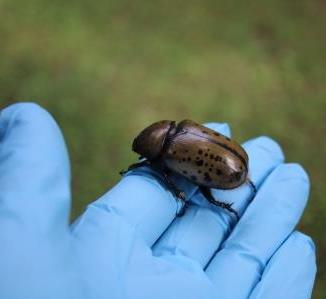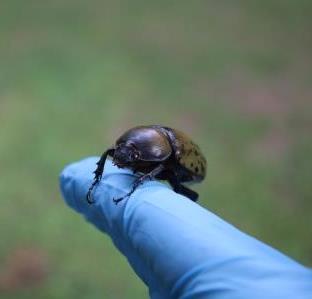While pulling weeds, I encountered this impressive beetle. It is a female Dynastes tityus. I felt lucky to find one. The grubs and the beetles are both large (grubs can be more than four inches long and adults can reach two-and-a-half inches), which means that they make a satisfying meal for predators such as skunks, raccoons and even spiders. The eggs fall prey to mites and maggots. Their meal-appeal means that Nature keeps populations in check. Please don’t run for the insecticide when you see one of these. The grubs live on decaying matter on the forest floor, so they are not damaging live plant roots.
The adult beetles range in color from green to gold; some have black spots and some do not. They are heavy for their size and strong, hence the common name “Hercules Beetle.” Insect authorities estimate that the Hercules Beetle can lift 100 to 800 times its own body weight. Even on the low end of the scale, that is like a 200 pound man lifting ten tons.
How do you tell the girls from the boys? Males have C-shaped horns on their heads, used to battle other males when competing for mating privileges. Those horns have led to their characterization as a “rhinoceros beetle.”
You will note that I handled this girl while wearing nitrile gloves. It wasn’t from the danger of being bitten. They do not bite, but when threatened they exude a nasty smell. This visitor to the Mary Snoddy garden is the Eastern Hercules Beetle. There are others in the same family found in many countries. Some places they are prized as pets. I recommend cats. Or dogs. Or both.


